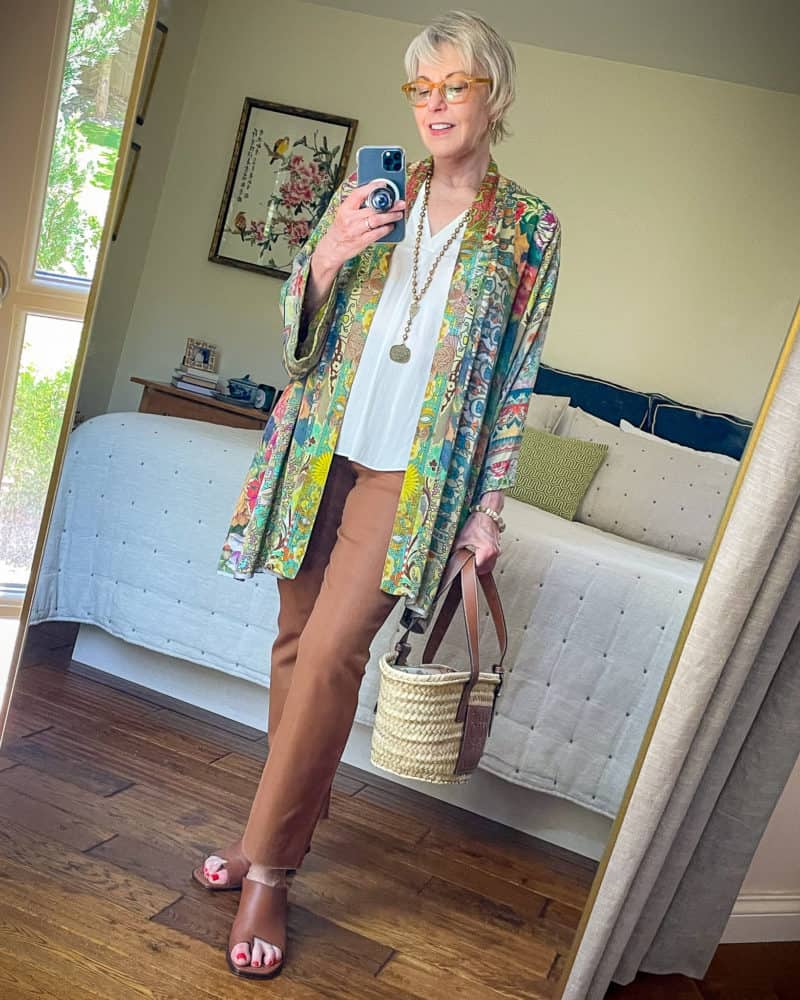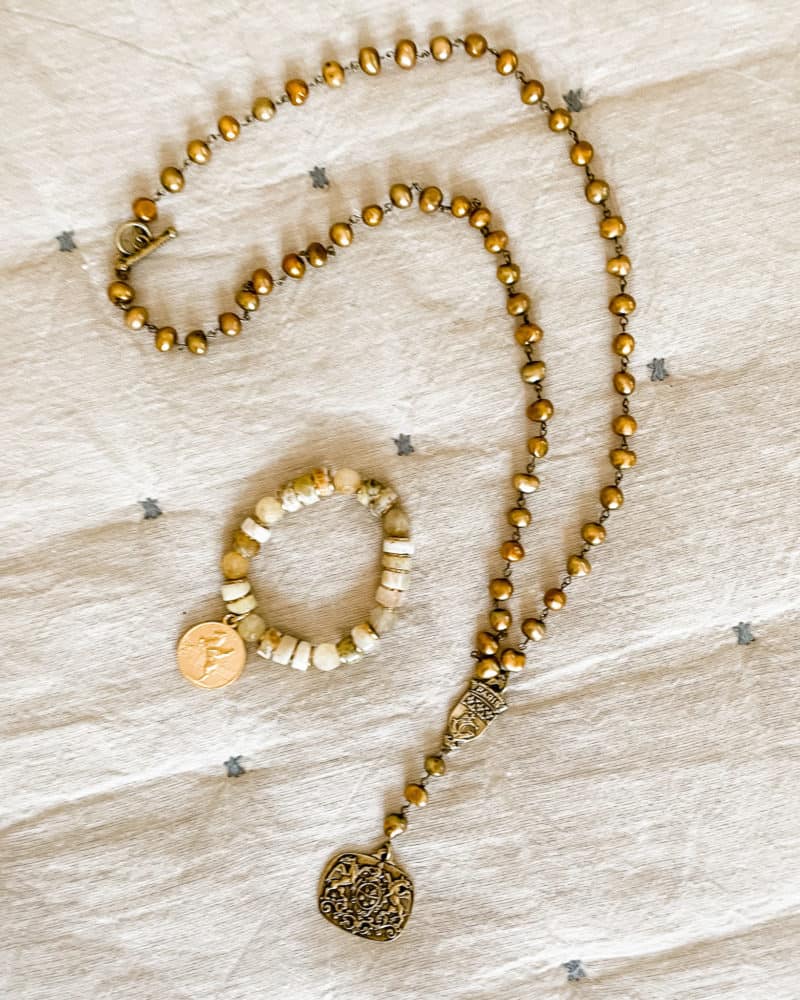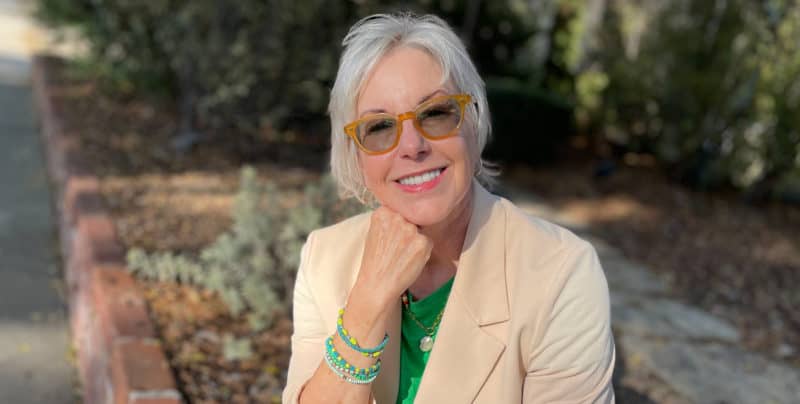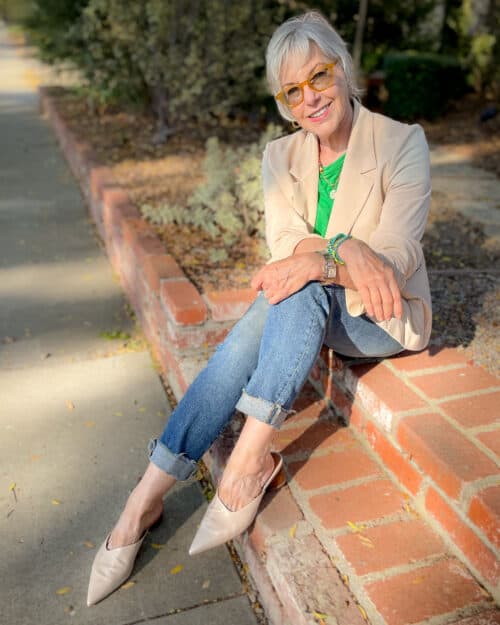A casual kimono outfit & reading the style tea leaves…
Over the weekend, I decided to heed my own suggestion, and put together this casual kimono outfit for a dinner out. We still opt for outdoor seating whenever it’s available, and early July here is still mostly mild. So a lightweight topper keeps me comfortable when those cool evening breezes pick up.
A casual kimono outfit

kimono/haori (similar) | top (Plus) | necklace | bracelet | bag | jeans (similar) | sandals (similar)
The kimono is from Johnny Was, purchased last year and is reversible. For the holiday weekend, Johnny Was has 20% off sitewide, including kimonos. (I’m using the term loosely here as the retailer has done, and am aware that a true kimono is a very specific garment.)
The jeans and sandals were both purchased last year, and I’ve had this top for quite a while.

Here’s a closeup of the jewelry, from the French Kande “Cité” collection. (bracelet | necklace) I just love those gold baroque pearls!
Your favorites & mine on sale…
Trying to read the style tea leaves
A few months into the pandemic, I figured that at some point soon (ha!) life would resume some normalcy, and we’d be back out in the world as we were before the Coronascene Period. And I was wondering whether the shift toward ever more casual clothing would continue, or whether we’d see a return to a more structured, polished aesthetic.
From my vantage point, it’s a mixture of both, though “oversized” still seems to dominate what’s available. My theory is that a looser, boxier fit is a) cheaper to produce and b) fits a wider range of bodies, so it’s not going to go away anytime soon. Yes, you can find more tailored pieces, and they will usually be more costly.
I also believe that more people are prioritizing comfort in their clothing. After months (or more) of working from home, I think there’s a widespread reluctance to go back to clothing that feels restrictive. So even trousers and blazers are looser and more oversized.
I think “elevated casual” is here to stay, at least for the foreseeable future.
Rack after rack of the same things…
One of the complaints that I hear most often about what’s available to purchase is that so much of it feels the same, season after season. I came across this article in the Atlantic recently that explains why: as with everything else, AI has a bigger role in what we’re being offered.
Rather than the “cerulean sequence” explained in The Devil Wears Prada, where than a human designer comes up with a new idea that gradually makes its way to mass retail, artificial intelligence and algorithms are now deciding what gets produced.
Fast fashion chains were the first to employ quick copycatting methods to turn out “new” trends in record time, and employ algorithms to churn out more of what is already selling. And this practice has spilled over…
When enough brands and retailers begin using these inventory tactics and trend-prediction methods, the results homogenize over time. At the top of the food chain, a designer has an interesting idea, and bigger, more efficient retailers don’t just copy it—they copy one another’s copies. The sameness persists on multiple levels—not only do lots of companies end up making garments that look very much alike, but for efficiency’s sake, they’re also often the same garments those companies made in past seasons, gussied up with new details…
An idea that would have been moderately popular a few decades ago, before petering out naturally, now sticks around in an endless present, like an unattended record that has begun to skip.
Amanda Mull
While the article focuses quite a bit on more trendy “Instagram-worthy” clothes, (flounces, ruffles, tiers) I think this is also why we see so much black/gray/white clothing, or muted colors and shapeless cuts. It can be frustrating when you’re looking for particular styles or colors that no one seems to be offering.
I don’t know that any of this is going to change anytime soon, unfortunately. I think the best we can do is to invest in pieces (when we find them) that suit our colors/style and that will last, while purchasing fewer pieces overall. Easier said than done, I know.
Happy Fourth!

Stay in touch
Sign up to be notified of new posts and updates from une femme d’un certain âge.


Hi Susan
Thanks for linking to the Atlantic article. It was very interesting and helps me make sense of what’s going on in the retail world right now.
I can only choose my clothes from what is made available to me in the shops and find it rather insulting that an algorithm can reduce my personal style and self-expression to such levels of dullness. Quality down. Imagination down. Choice down. Prices up! The result is a lot of unflatteringly dressed clones.
And I also resent merely being seen by manufacturers as just the final bit of the merchandising equation ie the unquestioning, unthinking, sadly-dressed woman who always pays up, whatever.
On the positive side, if nothing else makes the consumer reconsider her relationship with clothes purchasing, surely this will?
Ideas about how to beat this dreary mundanity are so welcome, Susan. I don’t want to buy wardrobes full of clothes now I’m retired but I do respect the power of what I wear to lift my spirits and enable my enjoyment of life. Merci!
Love, love, love your comment and agree with you wholeheartedly! I especially appreciate your last line about “the power of what I wear to lift my spirits and enable my enjoyment of life.” Beautifully said and I will continue to do that with a limited but classic wardrobe.
I have to second Jan’s post and Marianne’s comments. I’m also recently retired and feel similarly about the size and effect of a wardrobe appropriate to my style and lifestyle.
Thank you for the enlightening information on how and why clothing gets ‘designed’. My sister and I have been seeing at offerings and looking at each other with slack jaws. She said, ‘you remember our home ec teacher? She would’ve flunked us for these ‘garments’. When did compound wives become the height of fashion?” Needless to say it’s very much a hunting expedition to find things we like.
I have read your blog for a long time and look forward to each post. Your outfit styled today is one of your very best! Thank you for sharing your creativity with so many of us.
Coronascene Period – perfect! Lol.
Excellent article in the Atlantic! Thanks for sharing. I have always loved a kimono as a topper.
Thank you for explaining the continuing presence of puffs, ruffles, tiers, and flounces. I can’t seem to escape them! I’ve even caved in and bought a couple of items, but I ultimately feel they look rather ridiculous on my middle aged body. Even my beloved Talbots has fallen victim to this trend! No wonder coastal grandmother, with its more simplistic style, has become a thing!
That is a perfect dinner out outfit. I’ve been very frustrated with clothes shopping for the last 10 years and it’s only getting worse. Last week I went in person shopping to replace worn out basics and to look for a dress to wear to two September weddings. I was underwhelmed. As opposed to your other readers I’m finding simple basics to be impossible to find. Everything is brightly colored, floral, patterned, ruffled, cropped, oversized, tunic, the list goes on. I enjoy dressing in a classic, modern, but minimal manner. This is hard to find. I used to have no problem with finding Goldilocks clothes. Actually I’d find too much. I still have some of those items and I’m holding on to them for dear life. I looked for 6 months for a dress to wear to a June wedding and ended up wearing an old black wrap dress and it will have to do for the September weddings too.
What a great term, “Coronascene period.” I hadn’t thought about it before but I think you are correct about why we see so many boxy fit pieces of clothing; also, everything comes in S-M-L instead of numerical sizes for the same reason. It is very hard to get a good fit without alterations. Maybe you could do some posts on alterations/tailoring?
Thank you for the link to the article and your summary. This explains so much. I have read your blog for years and so appreciate you and what you do. You and the other fine lifestyle/fashion bloggers now provide thoughtful and engaging content–content we used to get in the golden age of fashion magazines. Social media platforms like yours provide focused (and yes entertaining) content we can use to our advantage. And frankly, it’s just as fun–if not more so –than thumbing through a magazine or wandering through a mall, looking for attractive visuals and realistic options. Rather like having access to a designer’s personalized style options instead of the bombardment of ever staler, often shoddy offerings season after season!
Hi Susan and thanks so much for your insights! I’ve gotten the same impression about the trend of clothing production and so I’ve resigned myself to hunker down and save for wardrobe pieces that are pricier and more tailored. It is frustrating—especially when I see such beautiful clothing being offered in Europe.
This was interesting. I agree it does seem every store you go in has the same styles. Now knowing how they determine this makes sense.
Love the kimono.
Happy 4th.
“I think this is also why we see so much black/gray/white clothing, or muted colors and shapeless cuts.” THIS! THIS! THIS! Thank you so much for saying this. I follow quite a number of fashion bloggers and the black/gray/white clothing they wear is so disappointing. I understand they are being compensated and have to peddle what their sponsor is selling but that doesn’t make it any less frustrating. I had my colors done via the CMB system and I’m always looking for spring colors. The solution is to look for what is right for me which means I am buying less clothes. (That’s not a bad thing!) Thanks for your post!
“Coronascene Period”! Wonderful. I hope the history books adopt your term. And that the fashion designers and producers move away from using AI to give us more and more of what we don’t want.
Welcome to capitalism and the almighty dollar. Of course clothing companies are going to make more of what sells. It’s not about us; it’s about them.
But what a beautiful outfit, Susan — I love it.
I get that fashion is a business…to me what’s happening though isn’t just that they’re making “what sells,” but are kind of locking themselves (and us) in a perpetual feedback loop, like what happens on social media, or with Hollywood making the same movies 5 over and over.
Fascinating article from The Atlantic–thank you for sharing. I suppose this is why I enjoy vintage/second hand shopping so much!
Fascinating article. Thanks for the link. Explain why puffy sleeves and cut out shoulders make their way into seemingly every line of clothing. Also why set-in sleeves seem to be disappearing. More and more I am making due with what I have, BTW, Love your look today.
Lovely outfit!
Echoing Abbey, this is why I like to shop secondhand, at consignment stores, vintage clothing shops, and online at Poshmark — I’m not stuck with what styles and colors stores are currently selling based on what suits THEM rather than me.
Great post. Funny all I see in the stores and on line is colorful print clothing or dull dusty shades. And voluminous shapes. I would like to find the black, gray and white!!!! I must be searching the wrong places.
Gaping arm holes in sleeveless items: check. Non-stop cropped pants and ankle pants, which don’t work in cold winters, or don’t work at all if you have a long torso like me: check. Rayon and polyester everywhere: check. Where have all the natural fibers gone?
I blame the black, gray and white on influencers who push minimalism. It’s all very fine to have a minimalist wardrobe in those items if those colors suit you. Presumably influencers want the rest of us to vanish.
The worst of all this is the shrinking size range, and the near-disappearance of the curvy fit. Strange, but men’s clothing has remained pretty much the same throughout all this.
I do think the preponderance of black clothing pre-dates the influencer era, though. I first began noticing it in the late 1990’s – early 2000’s.
Repetitive clothing design makes it difficult to find appropriate occasion dresses for the mother of the bride who doesn’t want what they offer for the “mother of the bride.” I buy a lot of second hand clothes in general now, but buying dresses second hand online is tricky.
Such an interesting thread. I do find myself shopping more like the Europeans I have known. I buy much better quality, buy much less, and think much more before I make a purchase. I only buy it if I can return it. Absolutely no puffed sleeves etc. for me. I do love some of the beautiful “boho” prints and I wish they were more available in fitted tops- i.e., as Jane Fonda as Grace wore them.
Jane Fonda’s wardrobe as Grace was just beautiful! But she has an ideal body for those clothes, it has to be said.
You look very stylish and put-together in this outfit. And yes, more of the same seems to be everywhere.
I have always favoured cut and the way it looks over comfort. Now that I am retired I am slowly going the other way and comfort is becoming key. It does mean I am not so smartly dressed anymore and I mourn for that. I really have to figure out what not to buy anymore (I still like corporate clothes like a fitted jacket) and what to buy for comfort AND style. I am doing pretty well on flat summer shoes which is a miracle.
Greetje
I’m also recently retired after two years of working from home. And like you, I’m trying to figure out “what to buy for comfort AND style”—there has to be a happy medium. I’m thinking that Susan’s “elevated casual” is likely the answer—translating that to my personal style is the issue. Fit, shape, plus ease.
I agree with your other readers–consigned/second hand clothing may be the way to go for now. I prefer a more tailored style because it looks better on me–the more voluminous styles “wear” me, regrettably. I have found wonderful clothes at consignment stores and on-line sites , and can choose colors and styles I know suit me. To avoid looking dated in my older “new” pieces, I purchase newer, on-trend shoes and bags and suddenly the outfit looks authentic, very “me”. Not a new trick certainly but one espoused by intelligent bloggers such as yourself, Susan. Thanks as always for your thoughtful, helpful commentary and the space you provide that enables us to hear from other smart, stylish women. We all learn from each other, n’est-ce pas?
This is such an interesting post, Susan, and underscores why you’re my favorite blogger. Thanks for the link to The Atlantic article — loved it — and your thoughtful discussion of the topic. Stultifying sameness is getting to me. You inspire me to look for “show ponies,” not just “work horses,” then I eagerly hit the stores only to be met with….acres of puffy sleeves. Endless crop pants in the same 3 solid colors everyone has. Sigh. Please keep up the inspiration — I need it
Susan, you look beautiful in that outfit, the kimono is gorgeous. I understand why you made that comment about it not being a real kimono. Someone might have accused you of cultural appropriation, especially in the USA.
This was a very interesting post, including the article from the Atlantic. And I totally agree with all those who commented that puff sleeves, cut-out shoulders and frills are truly ghastly!
There’s a really nice boutique near where I live called “Look à l’Europeenne ». Fortunately smart casual clothes are available there. No frills available!
Hello Susan, like many above, I’ve been reading your blog for years (since at least 2007). Your post today explains a lot about the fashion industry currently, thank you. By the way, you might prefer the term ‘haori’ if you’re a bit unsure about ‘kimono’. I just found out about them yesterday, this article is very interesting: https://japanobjects.com/features/haori
And here was I thinking it was just a New Zealand problem being such a tiny country at the bottom of the world; but not so apparently.
Brighter colours have always suited me best and are now increasingly rare in the shops.
I had always been so envious of overseas fashion offerings long before the days of online, but I’m not sure I can take comfort in realising it’s a global issue. A sad situation for all.
Buying online is also now fraught with frustration as both shipping costs and delivery delays have made overseas purchases almost impossible.
I’m reflecting on all the donations I’ve made to charity (thrift) shops over time and sad to think I may have been somewhat hasty when lured by something new in better times.
Ah…that beautiful kimono again! And I love your blouse but was frustrated that it can’t be purchased until Nordstrom’s Anniversary Sale. But…if you are a size small and want it in light lavender, you can find it on the TJ Maxx website…on sale for $14.
Susan, thanks to your recommendation several years ago, I now own four of those Vince Camuto rumpled-satin tops. (I seem to end up wearing mostly the off-white one—I wonder why.) Patricia, some colors of the top are available at Nordstrom now; search “sleeveless” and “rumpled satin.” I’ve seen discontinued colors at Nordstrom Rack, too.
P.S. “Coronascene” is excellent!
I love that kimono outfit and both patterns (I remember from last year) seem to work with your colors. I would love a reversible silk kimono but I can’t seem to find one where both sides are in the winter palette of colors. I’m petite size like you and some styles are too voluminous slso. Any ideas?
Your outfit is beautiful and all the pieces go well together, something that looks effortless but is not easy to do. The use of AI in the production of clothing is both fascinating and worrying. It gets harder and harder to find well-made clothes, in natural fabrics and at a reasonable price. I agree that buying fewer clothes, with discernment and after careful thought, is the best approach.
Thank you for this blog. I am following you for quite a few years and enjoying your intelligence.